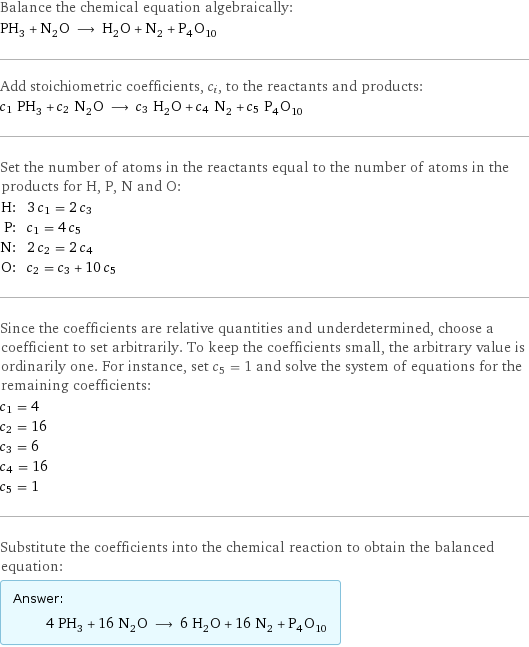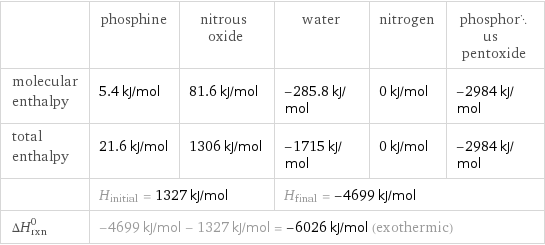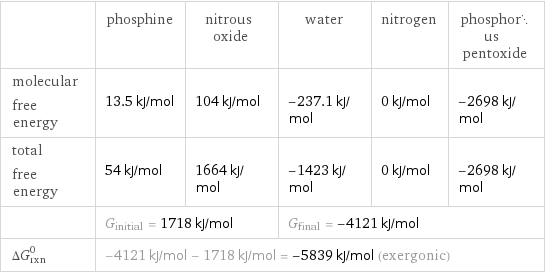Input interpretation

PH_3 phosphine + N_2O nitrous oxide ⟶ H_2O water + N_2 nitrogen + P_4O_10 phosphorus pentoxide
Balanced equation

Balance the chemical equation algebraically: PH_3 + N_2O ⟶ H_2O + N_2 + P_4O_10 Add stoichiometric coefficients, c_i, to the reactants and products: c_1 PH_3 + c_2 N_2O ⟶ c_3 H_2O + c_4 N_2 + c_5 P_4O_10 Set the number of atoms in the reactants equal to the number of atoms in the products for H, P, N and O: H: | 3 c_1 = 2 c_3 P: | c_1 = 4 c_5 N: | 2 c_2 = 2 c_4 O: | c_2 = c_3 + 10 c_5 Since the coefficients are relative quantities and underdetermined, choose a coefficient to set arbitrarily. To keep the coefficients small, the arbitrary value is ordinarily one. For instance, set c_5 = 1 and solve the system of equations for the remaining coefficients: c_1 = 4 c_2 = 16 c_3 = 6 c_4 = 16 c_5 = 1 Substitute the coefficients into the chemical reaction to obtain the balanced equation: Answer: | | 4 PH_3 + 16 N_2O ⟶ 6 H_2O + 16 N_2 + P_4O_10
Structures

+ ⟶ + +
Names

phosphine + nitrous oxide ⟶ water + nitrogen + phosphorus pentoxide
Reaction thermodynamics
Enthalpy

| phosphine | nitrous oxide | water | nitrogen | phosphorus pentoxide molecular enthalpy | 5.4 kJ/mol | 81.6 kJ/mol | -285.8 kJ/mol | 0 kJ/mol | -2984 kJ/mol total enthalpy | 21.6 kJ/mol | 1306 kJ/mol | -1715 kJ/mol | 0 kJ/mol | -2984 kJ/mol | H_initial = 1327 kJ/mol | | H_final = -4699 kJ/mol | | ΔH_rxn^0 | -4699 kJ/mol - 1327 kJ/mol = -6026 kJ/mol (exothermic) | | | |
Gibbs free energy

| phosphine | nitrous oxide | water | nitrogen | phosphorus pentoxide molecular free energy | 13.5 kJ/mol | 104 kJ/mol | -237.1 kJ/mol | 0 kJ/mol | -2698 kJ/mol total free energy | 54 kJ/mol | 1664 kJ/mol | -1423 kJ/mol | 0 kJ/mol | -2698 kJ/mol | G_initial = 1718 kJ/mol | | G_final = -4121 kJ/mol | | ΔG_rxn^0 | -4121 kJ/mol - 1718 kJ/mol = -5839 kJ/mol (exergonic) | | | |
Entropy

| phosphine | nitrous oxide | water | nitrogen | phosphorus pentoxide molecular entropy | 210 J/(mol K) | 220 J/(mol K) | 69.91 J/(mol K) | 192 J/(mol K) | 229 J/(mol K) total entropy | 840 J/(mol K) | 3520 J/(mol K) | 419.5 J/(mol K) | 3072 J/(mol K) | 229 J/(mol K) | S_initial = 4360 J/(mol K) | | S_final = 3720 J/(mol K) | | ΔS_rxn^0 | 3720 J/(mol K) - 4360 J/(mol K) = -639.5 J/(mol K) (exoentropic) | | | |
Equilibrium constant
![Construct the equilibrium constant, K, expression for: PH_3 + N_2O ⟶ H_2O + N_2 + P_4O_10 Plan: • Balance the chemical equation. • Determine the stoichiometric numbers. • Assemble the activity expression for each chemical species. • Use the activity expressions to build the equilibrium constant expression. Write the balanced chemical equation: 4 PH_3 + 16 N_2O ⟶ 6 H_2O + 16 N_2 + P_4O_10 Assign stoichiometric numbers, ν_i, using the stoichiometric coefficients, c_i, from the balanced chemical equation in the following manner: ν_i = -c_i for reactants and ν_i = c_i for products: chemical species | c_i | ν_i PH_3 | 4 | -4 N_2O | 16 | -16 H_2O | 6 | 6 N_2 | 16 | 16 P_4O_10 | 1 | 1 Assemble the activity expressions accounting for the state of matter and ν_i: chemical species | c_i | ν_i | activity expression PH_3 | 4 | -4 | ([PH3])^(-4) N_2O | 16 | -16 | ([N2O])^(-16) H_2O | 6 | 6 | ([H2O])^6 N_2 | 16 | 16 | ([N2])^16 P_4O_10 | 1 | 1 | [P4O10] The equilibrium constant symbol in the concentration basis is: K_c Mulitply the activity expressions to arrive at the K_c expression: Answer: | | K_c = ([PH3])^(-4) ([N2O])^(-16) ([H2O])^6 ([N2])^16 [P4O10] = (([H2O])^6 ([N2])^16 [P4O10])/(([PH3])^4 ([N2O])^16)](../image_source/8d42fedf697ac751441721ebe47ff9d5.png)
Construct the equilibrium constant, K, expression for: PH_3 + N_2O ⟶ H_2O + N_2 + P_4O_10 Plan: • Balance the chemical equation. • Determine the stoichiometric numbers. • Assemble the activity expression for each chemical species. • Use the activity expressions to build the equilibrium constant expression. Write the balanced chemical equation: 4 PH_3 + 16 N_2O ⟶ 6 H_2O + 16 N_2 + P_4O_10 Assign stoichiometric numbers, ν_i, using the stoichiometric coefficients, c_i, from the balanced chemical equation in the following manner: ν_i = -c_i for reactants and ν_i = c_i for products: chemical species | c_i | ν_i PH_3 | 4 | -4 N_2O | 16 | -16 H_2O | 6 | 6 N_2 | 16 | 16 P_4O_10 | 1 | 1 Assemble the activity expressions accounting for the state of matter and ν_i: chemical species | c_i | ν_i | activity expression PH_3 | 4 | -4 | ([PH3])^(-4) N_2O | 16 | -16 | ([N2O])^(-16) H_2O | 6 | 6 | ([H2O])^6 N_2 | 16 | 16 | ([N2])^16 P_4O_10 | 1 | 1 | [P4O10] The equilibrium constant symbol in the concentration basis is: K_c Mulitply the activity expressions to arrive at the K_c expression: Answer: | | K_c = ([PH3])^(-4) ([N2O])^(-16) ([H2O])^6 ([N2])^16 [P4O10] = (([H2O])^6 ([N2])^16 [P4O10])/(([PH3])^4 ([N2O])^16)
Rate of reaction
![Construct the rate of reaction expression for: PH_3 + N_2O ⟶ H_2O + N_2 + P_4O_10 Plan: • Balance the chemical equation. • Determine the stoichiometric numbers. • Assemble the rate term for each chemical species. • Write the rate of reaction expression. Write the balanced chemical equation: 4 PH_3 + 16 N_2O ⟶ 6 H_2O + 16 N_2 + P_4O_10 Assign stoichiometric numbers, ν_i, using the stoichiometric coefficients, c_i, from the balanced chemical equation in the following manner: ν_i = -c_i for reactants and ν_i = c_i for products: chemical species | c_i | ν_i PH_3 | 4 | -4 N_2O | 16 | -16 H_2O | 6 | 6 N_2 | 16 | 16 P_4O_10 | 1 | 1 The rate term for each chemical species, B_i, is 1/ν_i(Δ[B_i])/(Δt) where [B_i] is the amount concentration and t is time: chemical species | c_i | ν_i | rate term PH_3 | 4 | -4 | -1/4 (Δ[PH3])/(Δt) N_2O | 16 | -16 | -1/16 (Δ[N2O])/(Δt) H_2O | 6 | 6 | 1/6 (Δ[H2O])/(Δt) N_2 | 16 | 16 | 1/16 (Δ[N2])/(Δt) P_4O_10 | 1 | 1 | (Δ[P4O10])/(Δt) (for infinitesimal rate of change, replace Δ with d) Set the rate terms equal to each other to arrive at the rate expression: Answer: | | rate = -1/4 (Δ[PH3])/(Δt) = -1/16 (Δ[N2O])/(Δt) = 1/6 (Δ[H2O])/(Δt) = 1/16 (Δ[N2])/(Δt) = (Δ[P4O10])/(Δt) (assuming constant volume and no accumulation of intermediates or side products)](../image_source/47ce941d11aa8bbf2f8aaec6d48c6b20.png)
Construct the rate of reaction expression for: PH_3 + N_2O ⟶ H_2O + N_2 + P_4O_10 Plan: • Balance the chemical equation. • Determine the stoichiometric numbers. • Assemble the rate term for each chemical species. • Write the rate of reaction expression. Write the balanced chemical equation: 4 PH_3 + 16 N_2O ⟶ 6 H_2O + 16 N_2 + P_4O_10 Assign stoichiometric numbers, ν_i, using the stoichiometric coefficients, c_i, from the balanced chemical equation in the following manner: ν_i = -c_i for reactants and ν_i = c_i for products: chemical species | c_i | ν_i PH_3 | 4 | -4 N_2O | 16 | -16 H_2O | 6 | 6 N_2 | 16 | 16 P_4O_10 | 1 | 1 The rate term for each chemical species, B_i, is 1/ν_i(Δ[B_i])/(Δt) where [B_i] is the amount concentration and t is time: chemical species | c_i | ν_i | rate term PH_3 | 4 | -4 | -1/4 (Δ[PH3])/(Δt) N_2O | 16 | -16 | -1/16 (Δ[N2O])/(Δt) H_2O | 6 | 6 | 1/6 (Δ[H2O])/(Δt) N_2 | 16 | 16 | 1/16 (Δ[N2])/(Δt) P_4O_10 | 1 | 1 | (Δ[P4O10])/(Δt) (for infinitesimal rate of change, replace Δ with d) Set the rate terms equal to each other to arrive at the rate expression: Answer: | | rate = -1/4 (Δ[PH3])/(Δt) = -1/16 (Δ[N2O])/(Δt) = 1/6 (Δ[H2O])/(Δt) = 1/16 (Δ[N2])/(Δt) = (Δ[P4O10])/(Δt) (assuming constant volume and no accumulation of intermediates or side products)
Chemical names and formulas

| phosphine | nitrous oxide | water | nitrogen | phosphorus pentoxide formula | PH_3 | N_2O | H_2O | N_2 | P_4O_10 Hill formula | H_3P | N_2O | H_2O | N_2 | O_10P_4 name | phosphine | nitrous oxide | water | nitrogen | phosphorus pentoxide IUPAC name | phosphine | nitrous oxide | water | molecular nitrogen |